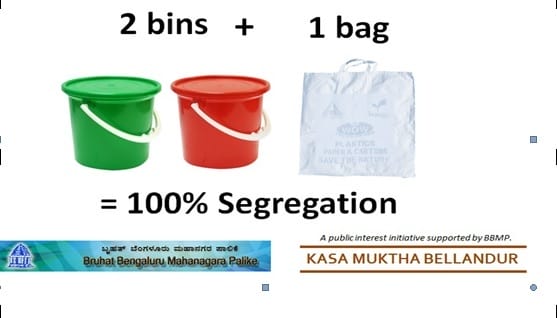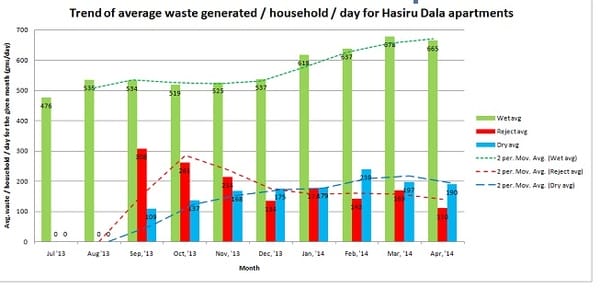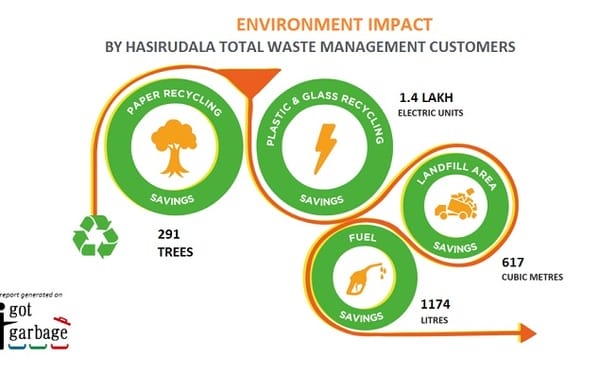
In mid 2013, deeply troubled by the wasted condition of their beloved city, when a group of concerned citizens got together to decode the garbage matrix, little did they expect that less than a year down the line, they would have so much cause for celebration. Their experiment in segregation at source developed into a winning formula, garnering unprecedented popularity as it moved on. Today, this simple formula has translated into saving over 291 trees, 1.4 lakh units of electricity, 1174 liters of fuel and 617 cubic meters of landfill area. Think of how Bangalore could be transformed if every ward had a group of committed volunteers such as these!
When Kasa Muktha Bellandur, a citizen initiative for Bellandur, BBMP ward 150 took shape in mid-2013, the idea was to provide an end-to-end solution for garbage, right from generation to disposal and to handle 80-90% of the garbage generated within the ward itself instead of transporting hundreds of kms away for ‘processing.’ The pilot started with three apartment complexes (~700 households). Today nearly a year since, it has scaled up to more than 7000 households spread over ~40 RWAs in the Bellandur ward.
At the core of this turnaround is a meticulously executed plan weaving together all the variables in the process.
Mantra is to keep it simple
Knowing how important it was to keep the front end simple, the SWM (Solid Waste Management) pilot came up with a hassle-free, colour-coded, three-way segregation model – the process to be followed by citizens or the generators of waste. This was different from the six-way model endorsed by the BBMP after the Mandur crisis and was effortlessly adopted wherever it was introduced.
Hard to believe that something as simple as two bins and one bag could revolutionize the way we think about garbage, but that was just it. The Green bin was for organic/food waste, the Red bin was for Reject or non-recyclable waste and the Blue bag was for dry/recyclable waste. The use of plastic liners/bags is totally discouraged in this model. The colour coding brought in standardization and ease of understanding for all stakeholders in the process. Moreover the volunteers handheld newer apartments through the initiation process and initial hiccups wherever it was introduced. Consequently, this model is now being adopted in other wards following waste segregation too.
The cost of the SWM kit (2 bin + 1 bag) along with a standard segregation pamphlet (to be distributed to each apartment) is to be borne by each participating RWA. In some RWAs, additional 100rs was collected from the monthly maintenance as a onetime cost for buying the color coded buckets and bags for each home. This is all it takes to kick start the process.
At the backend, one major roadblock was that despite residents segregating, vendors mixed up the waste during transportation. This was not only de-moralizing for segregation volunteers, but was also indicative of the malaise in the garbage pickup system.
The vendors wanted mixed waste. WHY?
Fact is that vendors were interested in only the high value dry waste such as metals, glass and hard plastic. The rest did not even make it as far as Mandur. Most of it got dumped a few kilometers away from source in open plots, roadside drains and dried up lakes, thus giving birth to Garbage City. The payment system for garbage pickup was loosely based on number of households in a community. Therefore, neither the community nor the vendor had a reason to segregate waste.
After much research and vendor-scouting, Kasa Muktha Bellandur team engaged with Hasirudala, an NGO that worked for the upliftment of rag-pickers. They have been an active partner and game changer in this pilot. They brought professionalism and organization to this hitherto un-organized sector and ensured that segregated waste remained segregated through pick up till the disposal point.
Key to success was the principle: More the garbage, more you pay.
Pure wet/organic waste was charged at a half rate than mixed waste or reject waste.
The differential waste charging model was a key factor influencing willingness to segregate on the part of garbage generators i.e. apartments/residents. The key point of difference between the Hasirudala model and that of the other vendors – private as well as BBMP – was that the charges were linked directly to the amount or weight of the generated garbage. More the garbage, more you pay. Moreover, pure wet/organic waste was charged at a lower rate than mixed waste or reject waste. This model placed responsibility squarely where it originated – that is, with the consumer. Hence, people had the economic incentive to segregate.
On the other hand, payment for dry waste was made to the RWA on a per kilogram basis, provided they are stored in hygienic, unsoiled state. Most RWAs used the earnings from dry waste to incentivize their housekeeping staff for their added efforts in waste collection. Many RWAs also undertook efforts to cut down their reject waste. One method was to move to eco-friendly leaf plates and reusable steel plates for their club-house parties to cut down on plastic/thermocol disposables which adds to reject waste.
The graph below shows how the amount of reject waste reduced over an 8 month period for the 7000 odd units that Hasirudala services.
Today the three kinds of waste are picked up separately by Hasirudala: the wet/organic waste is sent to KCDC (Karnataka Compost Development Corporation), dry waste is segregated further in Hasirudala’s own dry waste centers (DWC) and sent for final processing to various other vendors. Reject waste is sent to the BBMP trucks destined for Mandur. The amount of reject waste sent to Mandur is now less than 10% of what was being sent before the pilot.
What we have learnt from this pilot:
- Keep frontend simple. Color coded – 3 categories.
- Keep pick up vehicles separate for each waste stream.
- Garbage vendor must charge generator based on quantity and not on number of households. Charge higher for rejects stream.
Though this was started as a pilot at the ward level, more communities in Bellandur and across the city are adopting this and Hasirudala is scaling up to meet the requirements. While we wish them good luck for the road ahead, we sincerely hope that the city government and BBMP adopt this simple color coded method for bulk generators across the city. The numbers speak for themselves, two bins and one bag is all it takes to be waste wise! Join the trend, save your city!
If you need more information, please contact us at https://www.facebook.com/groups/kasamukthabellandur
To see the public documents related to Bellandur ward, click here.

In my apartment complex in Chikkallasandra, we have already started segregated garbage collection as per the norms laid by BBMP. They have also inspected and appreciated our support.